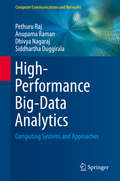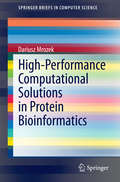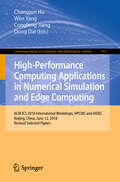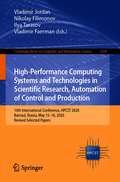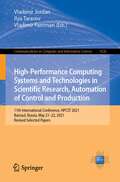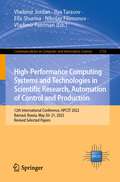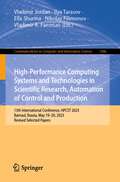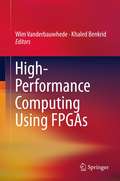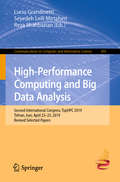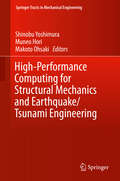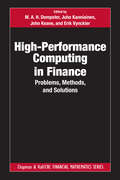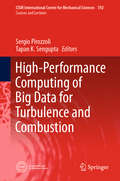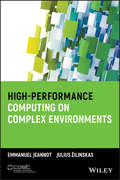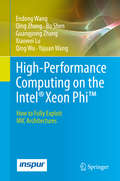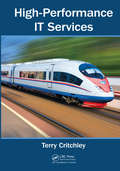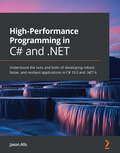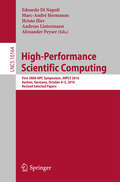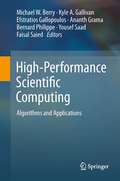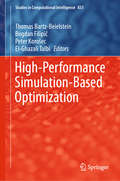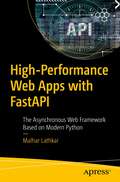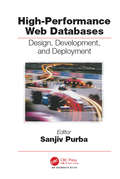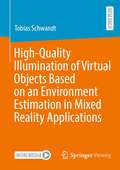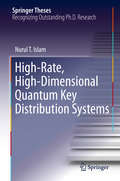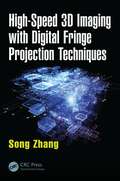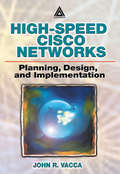- Table View
- List View
High-Performance Big-Data Analytics
by Pethuru Raj Anupama Raman Dhivya Nagaraj Siddhartha DuggiralaThis book presents a detailed review of high-performance computing infrastructures for next-generation big data and fast data analytics. Features: includes case studies and learning activities throughout the book and self-study exercises in every chapter; presents detailed case studies on social media analytics for intelligent businesses and on big data analytics (BDA) in the healthcare sector; describes the network infrastructure requirements for effective transfer of big data, and the storage infrastructure requirements of applications which generate big data; examines real-time analytics solutions; introduces in-database processing and in-memory analytics techniques for data mining; discusses the use of mainframes for handling real-time big data and the latest types of data management systems for BDA; provides information on the use of cluster, grid and cloud computing systems for BDA; reviews the peer-to-peer techniques and tools and the common information visualization techniques, used in BDA.
High-Performance Computational Solutions in Protein Bioinformatics
by Dariusz MrozekRecent developments in computer science enable algorithms previously perceived as too time-consuming to now be efficiently used for applications in bioinformatics and life sciences. This work focuses on proteins and their structures, protein structure similarity searching at main representation levels and various techniques that can be used to accelerate similarity searches. Divided into four parts, the first part provides a formal model of 3D protein structures for functional genomics, comparative bioinformatics and molecular modeling. The second part focuses on the use of multithreading for efficient approximate searching on protein secondary structures. The third and fourth parts concentrate on finding 3D protein structure similarities with the support of GPUs and cloud computing. Parts three and four both describe the acceleration of different methods. The text will be of interest to researchers and software developers working in the field of structural bioinformatics and biomedical databases.
High-Performance Computing Applications in Numerical Simulation and Edge Computing: ACM ICS 2018 International Workshops, HPCMS and HiDEC, Beijing, China, June 12, 2018, Revised Selected Papers (Communications in Computer and Information Science #913)
by Wen Yang Changjun Hu Congfeng Jiang Dong DaiThis book constitutes the referred proceedings of two workshops held at the 32nd ACM International Conference on Supercomputing, ACM ICS 2018, in Beijing, China, in June 2018. This volume presents the papers that have been accepted for the following workshops: Second International Workshop on High Performance Computing for Advanced Modeling and Simulation in Nuclear Energy and Environmental Science, HPCMS 2018, and First International Workshop on HPC Supported Data Analytics for Edge Computing, HiDEC 2018. The 20 full papers presented during HPCMS 2018 and HiDEC 2018 were carefully reviewed and selected from numerous submissions. The papers reflect such topics as computing methodologies; parallel algorithms; simulation types and techniques; machine learning.
High-Performance Computing Systems and Technologies in Scientific Research, Automation of Control and Production: 10th International Conference, HPCST 2020, Barnaul, Russia, May 15–16, 2020, Revised Selected Papers (Communications in Computer and Information Science #1304)
by Vladimir Jordan Nikolay Filimonov Ilya Tarasov Vladimir FaermanThis book constitutes selected revised and extended papers from the 10th International Conference on High-Performance Computing Systems and Technologies in Scientific Research, Automation of Control and Production, HPCST 2020, Barnaul, Russia, in May 2020. Due to the COVID-19 pancemic the conference was partly held in virtual mode. The 14 full papers presented in this volume were thoroughly reviewed and selected form 51 submissions. The papers are organized in topical sections on hardware for high-performance computing and its applications; information technologies and computer simulation of physical phenomena.
High-Performance Computing Systems and Technologies in Scientific Research, Automation of Control and Production: 11th International Conference, HPCST 2021, Barnaul, Russia, May 21–22, 2021, Revised Selected Papers (Communications in Computer and Information Science #1526)
by Vladimir Jordan Ilya Tarasov Vladimir FaermanThis book constitutes selected revised and extended papers from the 11th International Conference on High-Performance Computing Systems and Technologies in Scientific Research, Automation of Control and Production, HPCST 2021, Barnaul, Russia, in May 2021. The 32 full papers presented in this volume were thoroughly reviewed and selected form 98 submissions. The papers are organized in topical sections on Hardware for High-Performance Computing and Signal Processing; Information Technologies and Computer Simulation of Physical Phenomena; Computing Technologies in Discrete Mathematics and Decision Making; Information and Computing Technologies in Automation and Control Science; and Computing Technologies in Information Security Applications.
High-Performance Computing Systems and Technologies in Scientific Research, Automation of Control and Production: 12th International Conference, HPCST 2022, Barnaul, Russia, May 20–21, 2022, Revised Selected Papers (Communications in Computer and Information Science #1733)
by Vladimir Jordan Nikolay Filimonov Ilya Tarasov Vladimir Faerman Ella ShurinaThis book constitutes the refereed proceedings of the 12th International Conference on High-Performance Computing Systems and Technologies in Scientific Research, Automation of Control and Production, HPCST 2022, held in Barnaul, Russia, during May 20–21, 2022. The 23 full papers included in this book were carefully reviewed and selected from 116 submissions. They were organized in topical sections as follows: hardware for high-performance computing and signal processing; information technologies and computer simulation of physical phenomena; computing technologies in data analysis and decision making; and computing technologies in information security applications.
High-Performance Computing Systems and Technologies in Scientific Research, Automation of Control and Production: 13th International Conference, HPCST 2023, Barnaul, Russia, May 19–20, 2023, Revised Selected Papers (Communications in Computer and Information Science #1986)
by Vladimir Jordan Nikolay Filimonov Ilya Tarasov Ella Shurina Vladimir A. FaermanThis book constitutes the revised selected papers of the 13th International Conference on HPCST 2023, held in Barnaul, Russia, during May 19–20, 2023.The 21 full papers included in this book were carefully reviewed and selected from 81 submissions. The papers are organized in topical sections as follows: Hardware for High-Performance Computing and Signal Processing; Information Technologies and Computer Simulation of Physical Phenomena; Computing Technologies in Data Analysis and Decision Making; Information and Computing Technologies in Automation and Control Science; Computing Technologies in Information Security Applications.
High-Performance Computing Using FPGAs
by Khaled Benkrid Wim VanderbauwhedeHigh-Performance Computing using FPGA covers the area of high performance reconfigurable computing (HPRC). This book provides an overview of architectures, tools and applications for High-Performance Reconfigurable Computing (HPRC). FPGAs offer very high I/O bandwidth and fine-grained, custom and flexible parallelism and with the ever-increasing computational needs coupled with the frequency/power wall, the increasing maturity and capabilities of FPGAs, and the advent of multicore processors which has caused the acceptance of parallel computational models. The Part on architectures will introduce different FPGA-based HPC platforms: attached co-processor HPRC architectures such as the CHREC's Novo-G and EPCC's Maxwell systems; tightly coupled HRPC architectures, e.g. the Convey hybrid-core computer; reconfigurably networked HPRC architectures, e.g. the QPACE system, and standalone HPRC architectures such as EPFL's CONFETTI system. The Part on Tools will focus on high-level programming approaches for HPRC, with chapters on C-to-Gate tools (such as Impulse-C, AutoESL, Handel-C, MORA-C++); Graphical tools (MATLAB-Simulink, NI LabVIEW); Domain-specific languages, languages for heterogeneous computing(for example OpenCL, Microsoft's Kiwi and Alchemy projects). The part on Applications will present case from several application domains where HPRC has been used successfully, such as Bioinformatics and Computational Biology; Financial Computing; Stencil computations; Information retrieval; Lattice QCD; Astrophysics simulations; Weather and climate modeling.
High-Performance Computing and Big Data Analysis: Second International Congress, TopHPC 2019, Tehran, Iran, April 23–25, 2019, Revised Selected Papers (Communications in Computer and Information Science #891)
by Lucio Grandinetti Seyedeh Leili Mirtaheri Reza ShahbazianThis book constitutes revised and selected papers from the Second International Congress on High-Performance Computing and Big Data Analysis, TopHPC 2019, held in Tehran, Iran, in April 2019.The 37 full papers and 2 short papers presented in this volume were carefully reviewed and selected from a total of 103 submissions. The papers in the volume are organized acording to the following topical headings: deep learning; big data analytics; Internet of Things.- data mining, neural network and genetic algorithms; performance issuesand quantum computing.
High-Performance Computing for Structural Mechanics and Earthquake/Tsunami Engineering
by Makoto Ohsaki Shinobu Yoshimura Muneo HoriHuge earthquakes and tsunamis have caused serious damage to important structures such as civil infrastructure elements, buildings and power plants around the globe. To quantitatively evaluate such damage processes and to design effective prevention and mitigation measures, the latest high-performance computational mechanics technologies, which include telascale to petascale computers, can offer powerful tools. The phenomena covered in this book include seismic wave propagation in the crust and soil, seismic response of infrastructure elements such as tunnels considering soil-structure interactions, seismic response of high-rise buildings, seismic response of nuclear power plants, tsunami run-up over coastal towns and tsunami inundation considering fluid-structure interactions. The book provides all necessary information for addressing these phenomena, ranging from the fundamentals of high-performance computing for finite element methods, key algorithms of accurate dynamic structural analysis, fluid flows with free surfaces, and fluid-structure interactions, to practical applications with detailed simulation results. The book will offer essential insights for researchers and engineers working in the field of computational seismic/tsunami engineering.
High-Performance Computing in Finance: Problems, Methods, and Solutions (Chapman and Hall/CRC Financial Mathematics Series)
by M. A. H. Dempster, Juho Kanniainen, John Keane and Erik VynckierHigh-Performance Computing (HPC) delivers higher computational performance to solve problems in science, engineering and finance. There are various HPC resources available for different needs, ranging from cloud computing– that can be used without much expertise and expense – to more tailored hardware, such as Field-Programmable Gate Arrays (FPGAs) or D-Wave’s quantum computer systems. High-Performance Computing in Finance is the first book that provides a state-of-the-art introduction to HPC for finance, capturing both academically and practically relevant problems.
High-Performance Computing of Big Data for Turbulence and Combustion (CISM International Centre for Mechanical Sciences #592)
by Tapan K. Sengupta Sergio PirozzoliThis book provides state-of-art information on high-accuracy scientific computing and its future prospects, as applicable to the broad areas of fluid mechanics and combustion, and across all speed regimes. Beginning with the concepts of space-time discretization and dispersion relation in numerical computing, the foundations are laid for the efficient solution of the Navier-Stokes equations, with special reference to prominent approaches such as LES, DES and DNS. The basis of high-accuracy computing is rooted in the concept of stability, dispersion and phase errors, which require the comprehensive analysis of discrete computing by rigorously applying error dynamics. In this context, high-order finite-difference and finite-volume methods are presented. Naturally, the coverage also includes fundamental notions of high-performance computing and advanced concepts on parallel computing, including their implementation in prospective hexascale computers. Moreover, the book seeks to raise the bar beyond the pedagogical use of high-accuracy computing by addressing more complex physical scenarios, including turbulent combustion. Tools like proper orthogonal decomposition (POD), proper generalized decomposition (PGD), singular value decomposition (SVD), recursive POD, and high-order SVD in multi-parameter spaces are presented. Special attention is paid to bivariate and multivariate datasets in connection with various canonical flow and heat transfer cases. The book mainly addresses the needs of researchers and doctoral students in mechanical engineering, aerospace engineering, and all applied disciplines including applied mathematics, offering these readers a unique resource.
High-Performance Computing on Complex Environments
by Julius Zilinskas Emmanuel Jeannot* Covers cutting-edge research in HPC on complex environments, following an international collaboration of members of the ComplexHPC * Explains how to efficiently exploit heterogeneous and hierarchical architectures and distributed systems* Twenty-three chapters and over 100 illustrations cover domains such as numerical analysis, communication and storage, applications, GPUs and accelerators, and energy efficiency
High-Performance Computing on the Intel® Xeon PhiTM
by Bo Shen Qing Zhang Endong Wang Guangyong Zhang Xiaowei Lu Qing Wu Yajuan WangThe aim of this book is to explain to high-performance computing (HPC) developers how to utilize the Intel® Xeon Phi(tm) series products efficiently. To that end, it introduces some computing grammar, programming technology and optimization methods for using many-integrated-core (MIC) platforms and also offers tips and tricks for actual use, based on the authors' first-hand optimization experience. The material is organized in three sections. The first section, "Basics of MIC", introduces the fundamentals of MIC architecture and programming, including the specific Intel MIC programming environment. Next, the section on "Performance Optimization" explains general MIC optimization techniques, which are then illustrated step-by-step using the classical parallel programming example of matrix multiplication. Finally, "Project development" presents a set of practical and experience-driven methods for using parallel computing in application projects, including how to determine if a serial or parallel CPU program is suitable for MIC and how to transplant a program onto MIC. This book appeals to two main audiences: First, software developers for HPC applications - it will enable them to fully exploit the MIC architecture and thus achieve the extreme performance usually required in biological genetics, medical imaging, aerospace, meteorology and other areas of HPC. Second, students and researchers engaged in parallel and high-performance computing - it will guide them on how to push the limits of system performance for HPC applications.
High-Performance IT Services
by Terry CritchleyThis book on performance fundamentals covers UNIX, OpenVMS, Linux, Windows, and MVS. Most of the theory and systems design principles can be applied to other operating systems, as can some of the benchmarks. The book equips professionals with the ability to assess performance characteristics in unfamiliar environments. It is suitable for practitioners, especially those whose responsibilities include performance management, tuning, and capacity planning. IT managers with a technical outlook also benefit from the book as well as consultants and students in the world of systems for the first time in a professional capacity.
High-Performance Programming in C# and .NET: Understand the nuts and bolts of developing robust, faster, and resilient applications in C# 10.0 and .NET 6
by Jason AllsEnhance your applications' performance using best practices for benchmarking, application profiling, asynchronous programming, designing responsive UIs, gRPC communication, and distributed applicationsKey FeaturesMake the best use of performance enhancements in C# 10.0 and .NET 6Boost application performance by identifying hardware bottlenecks and common performance pitfallsGet to grips with best practices and techniques for improving the scalability of distributed systemsBook DescriptionWriting high-performance code while building an application is crucial, and over the years, Microsoft has focused on delivering various performance-related improvements within the .NET ecosystem. This book will help you understand the aspects involved in designing responsive, resilient, and high-performance applications with the new version of C# and .NET.You will start by understanding the foundation of high-performance code and the latest performance-related improvements in C# 10.0 and .NET 6. Next, you'll learn how to use tracing and diagnostics to track down performance issues and the cause of memory leaks. The chapters that follow then show you how to enhance the performance of your networked applications and various ways to improve directory tasks, file tasks, and more. Later, you'll go on to improve data querying performance and write responsive user interfaces. You'll also discover how you can use cloud providers such as Microsoft Azure to build scalable distributed solutions. Finally, you'll explore various ways to process code synchronously, asynchronously, and in parallel to reduce the time it takes to process a series of tasks.By the end of this C# programming book, you'll have the confidence you need to build highly resilient, high-performance applications that meet your customer's demands.What you will learnUse correct types and collections to enhance application performanceProfile, benchmark, and identify performance issues with the codebaseExplore how to best perform queries on LINQ to improve an application's performanceEffectively utilize a number of CPUs and cores through asynchronous programmingBuild responsive user interfaces with WinForms, WPF, MAUI, and WinUIBenchmark ADO.NET, Entity Framework Core, and Dapper for data accessImplement CQRS and event sourcing and build and deploy microservicesWho this book is forThis book is for software engineers, professional software developers, performance engineers, and application profilers looking to improve the speed of their code or take their skills to the next level to gain a competitive advantage. You should be a proficient C# programmer who can already put the language to good use and is also comfortable using Microsoft Visual Studio 2022.
High-Performance Scientific Computing
by Marc-André Hermanns Hristo Iliev Andreas Lintermann Alexander Peyser Edoardo Di NapoliThis book constitutes the thoroughly refereed post-conference proceedings of the First JARA High-Performance Computing Symposium, JARA-HPC 2016, held in Aachen, Germany, in October 2016.The 21 full papers presented were carefully reviewed and selected from 26 submissions. They cover many diverse topics, such as coupling methods and strategies in Computational Fluid Dynamics (CFD), performance portability and applications in HPC, as well as provenance tracking for large-scale simulations.
High-Performance Scientific Computing
by Kyle A. Gallivan Ananth Grama Faisal Saied Bernard Philippe Efstratios Gallopoulos Michael W. Berry Yousef SaadThis book presents the state of the art in parallel numerical algorithms, applications, architectures, and system software. The book examines various solutions for issues of concurrency, scale, energy efficiency, and programmability, which are discussed in the context of a diverse range of applications. Features: includes contributions from an international selection of world-class authorities; examines parallel algorithm-architecture interaction through issues of computational capacity-based codesign and automatic restructuring of programs using compilation techniques; reviews emerging applications of numerical methods in information retrieval and data mining; discusses the latest issues in dense and sparse matrix computations for modern high-performance systems, multicores, manycores and GPUs, and several perspectives on the Spike family of algorithms for solving linear systems; presents outstanding challenges and developing technologies, and puts these in their historical context.
High-Performance Simulation-Based Optimization (Studies in Computational Intelligence #833)
by El-Ghazali Talbi Peter Korošec Thomas Bartz-Beielstein Bogdan FilipičThis book presents the state of the art in designing high-performance algorithms that combine simulation and optimization in order to solve complex optimization problems in science and industry, problems that involve time-consuming simulations and expensive multi-objective function evaluations. As traditional optimization approaches are not applicable per se, combinations of computational intelligence, machine learning, and high-performance computing methods are popular solutions. But finding a suitable method is a challenging task, because numerous approaches have been proposed in this highly dynamic field of research. That’s where this book comes in: It covers both theory and practice, drawing on the real-world insights gained by the contributing authors, all of whom are leading researchers. Given its scope, if offers a comprehensive reference guide for researchers, practitioners, and advanced-level students interested in using computational intelligence and machine learning to solve expensive optimization problems.
High-Performance Web Apps with FastAPI: The Asynchronous Web Framework Based on Modern Python
by Malhar LathkarBuild APIs and web apps based on Asynchronous Server Gateway Interface (ASGI). This book provides a comprehensive explanation of using Pydantic models to construct the request/response objects in a FASTAPI path operation. You’ll start by reviewing type hints in Python and the asynchronous processing concepts. One of the highlights of FastAPI is its auto generation of API docs. Pydantic library is the main pillar on top of which FastAPI is built. You’ll see that ASGI has a far better performance compared to most of the other popular Python frameworks as they implement Web server Gateway Interface (WSGI), which is synchronous in nature and hence having slower response time. This book thoroughly explains how FastAPI interacts asynchronously with relational as well as NOSQL databases. Modern web apps use template engines to interact with the front-end. In this book, you will learn to use jinja2 templates and static assets. Swagger UI and OpenAPI standards are also covered in detail. Finally, different options of deployment of FastAPI app have been explored in this book. This book uses practical examples to empower you to build high performance APIsWhat You'll LearnDevelop robust and high-performance web appsDeploy the FastAPI app for public availability using cloud services such as Deta and Docker containerUnderstand the important building blocks of a web app such as form handling, templating and database interactionWho This Book Is ForAspiring and the experienced Python developers looking to leverage the flexibility of Python and the powerful features introduced in Modern Python. Computer science Engineering students at graduate and postgraduate level will also benefit immensely from the practical approach adapted in the book.
High-Performance Web Databases: Design, Development, and Deployment
by Sanjiv PurbaAs Web-based systems and e-commerce carry businesses into the 21st century, databases are becoming workhorses that shoulder each and every online transaction. For organizations to have effective 24/7 Web operations, they need powerhouse databases that deliver at peak performance-all the time. High Performance Web Databases: Design, Development, and
High-Quality Illumination of Virtual Objects Based on an Environment Estimation in Mixed Reality Applications
by Tobias SchwandtVisualizations of virtual objects in the real environment is often done by a simplified representation with simple surfaces and without reference to the surrounding environment. The seamless fusion of the virtual and real environment is, however, an essential factor in many areas, which is of particular importance when calculating lighting in mixed realities on mobile devices. Current approaches focus on approximations, which allow the calculation of diffuse lighting, whereby the rendering of glossy reflection properties is often neglected. The aim of this book is to enable the visualization of mirror-like reflective surfaces in mixed reality. In order to achieve this goal, various approaches are explored enabling high-quality visualization of virtual objects in realtime with a focus on the use of common hardware such as cameras, sensors in mobile devices, and partially depth sensors. Complete ambient lighting can be estimated, which enables detailed reflections. The results provide a novel way to embed complex and simple geometric shapes with glossy surfaces in the real world which offers a higher level of detail in the reflections without using additional hardware.
High-Rate, High-Dimensional Quantum Key Distribution Systems (Springer Theses)
by Nurul T. IslamThis book describes a broad research program on quantum communication. Here, a cryptographic key is exchanged by two parties using quantum states of light and the security of the system arises from the fundamental properties of quantum mechanics. The author developed new communication protocols using high-dimensional quantum states so that more than one classical bit is transferred by each photon. This approach helps circumvent some of the non-ideal properties of the experimental system, enabling record key rates on metropolitan distance scales. Another important aspect of the work is the encoding of the key on high-dimensional phase-randomized weak coherent states, combined with so-called decoy states to thwart a class of possible attacks on the system. The experiments are backed up by a rigorous security analysis of the system, which accounts for all known device non-idealities. The author goes on to demonstrate a scalable approach for increasing the dimension of the quantum states, and considers attacks on the system that use optimal quantum cloning techniques. This thesis captures the current state-of-the-art of the field of quantum communication in laboratory systems, and demonstrates that phase-randomized weak coherent states have application beyond quantum communication.
High-Speed 3D Imaging with Digital Fringe Projection Techniques (Optical Sciences and Applications of Light)
by Song ZhangDigital fringe projection (DFP) techniques are used for non-contact shape measurement of 3D images. In the rapidly expanding field of 3D high-speed imaging, the demand for DFP continues to grow due to the technology’s fast speed, flexibility, low cost, and high accuracy.High-Speed 3D Imaging with Digital Fringe Projection Techniques discusses the generation of digital fringe with digital video projection devices, covering a variety of core technical aspects. The book begins by establishing the theoretical foundations of fringe pattern analysis, reviewing various 3D imaging techniques while highlighting the advantages of DFP. The author then: Describes the differences between digital light processing (DLP), liquid crystal display (LCD), and liquid crystal on silicon (LCoS) Explains how to unwrap phase maps temporally and spatially Shows how to generate fringe patterns with video projectors Demonstrates how to convert phase to coordinates through system calibrations Provides a detailed example of a built-from-scratch 3D imaging system Incorporating valuable insights gained during the author’s 15+ years of 3D imaging research, High-Speed 3D Imaging with Digital Fringe Projection Techniques illuminates the pathway to advancement in high-speed 3D optical imaging using DFP.
High-Speed Cisco Networks: Planning, Design, and Implementation
by John R. VaccaHigh-Speed Cisco Networks: Planning, Design, and Implementation covers LAN/WAN technology and its benefits. The book lays out Cisco's complete line of products and describes their features and best applications. It provides critical details on routers and servers, switches and hubs, security products, network management tools, ATM products, other services and programs, and Internetwork Operating Systems (IOS). Cisco's routers, hubs, and switches are the core of the Internet and today's high-speed networks. Armed with this independent evaluation, the reader can design high-speed networks that meet current needs and scale to future requirements with confidence.
